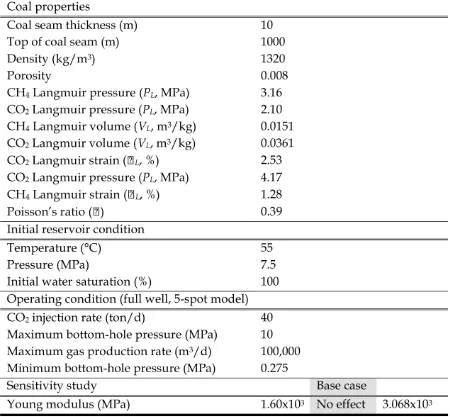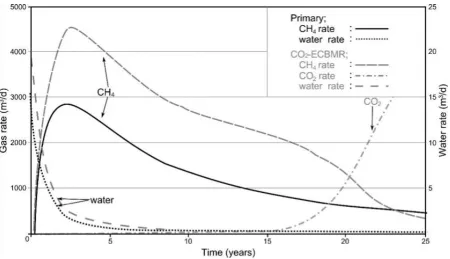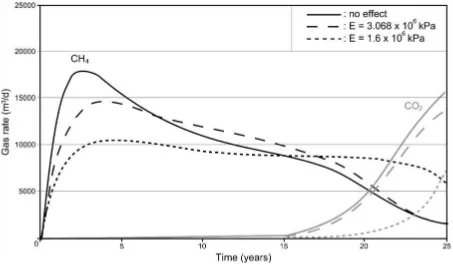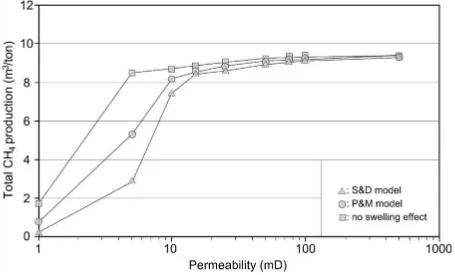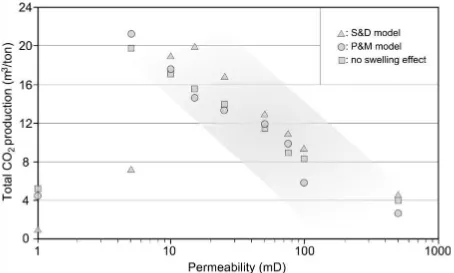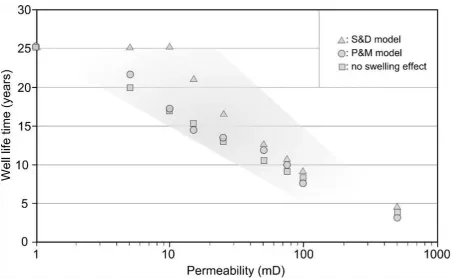NUMERICAL MODELLING AND SIMULATION
OF CO
2
–ENHANCED COAL-BED METHANE
RECOVERY (CO
2
-ECBMR): THE EFFECT OF
COAL SWELLING ON GAS PRODUCTION
PERFORMANCE
Ferian Anggara*1, Kyuro Sasaki2, and Yuichi Sugai2
1Department of Geological Engineering, Gadjah Mada University, Yogyakarta, Indonesia 2Department of Earth Resources Engineering, Kyushu University, Fukuoka 819-0395 Japan
Abstract
This presents study investigate the effect of swelling on gas production performances at coal reser-voirs during CO2-ECBMR processes. The
stress-dependent permeability-models to express effect of coal matrix shrinkage/swelling using Palmer and Mansoori (P&M) and Shi and Durucan (S&D) models were constructed based on present experi-mental results for typical coal reservoirs with the distance of 400 to 800 m between injection and production wells. By applying the P&M and S&D models, the numerical simulation results showed that CH4 production rate was decreasing and peak
production time was delayed due to effect of stress and permeability changes caused by coal matrix swelling. The total CH4production ratio of swelling
effect/no-swelling was simulated as 0.18 to 0.95 for permeability 1 to 100 mD, respectively. It has been cleared that swelling affects gas production at per-meability 1 to 15 mD, however, it can be negligible at permeability over 15 mD.
Keywords: Coal swelling in CO2, Permeability,
Low rank coal, CO2-ECBMR
*Corresponding author: F. ANGGARA,
Depart-ment of Geological Engineering, Gadjah Mada Univer-sity. Jl. Grafika 2 Yogyakarta, Indonesia. E-mail: [email protected]
1 Introduction
In regard to simulate the effect of swelling and others factors in field scale, a numeri-cal modelling of CO2-ECBMR has been
con-structed. The reservoir simulator used for the study was ECLIPSE E300, 2012.1 by Schlum-berger (SchlumSchlum-berger, 2012) which have incor-porated dual porosity model, sorption and dif-fusion processes, as well as coal shrinkage and compaction effects. A modified Warren and Root model (Warren and Root, 1963) have been used to describe dual porosity process in coal bed methane model. The adsorbed concentra-tion on micro-pore in coal surface is assumed to be a function of pressure only and described by Langmuir isotherm. To accommodate differ-ent gases on CO2-ECBMR project, an extended
Langmuir isotherm is used to describe the coal sorption for different components. The diffu-sive flow of gas from the matrix to cleat system is given by Fick’s law while from cleat to well be governed by Darcy law. Rock compaction is used to model the compression and expansion of the pore volume and its effect on permeabil-ity.
ther lower or higher values were determined for sensitivity studies.
To reduce total grid cell and to optimize the computational speed, well spacing were mod-elled as ¼ model as shown in Figure 1. Syn-thetic data and isotropic block model were used instead of real field data. Thus full model data was based on a multiply of ¼ model.
3 Numerical Model Result
One of the main objectives to carry CO2
injec-tion into coal reservoir is to enhance CH4
pro-duction (CO2-ECBMR) compared to primary
CH4 recovery. Figure 2 shows the comparison
of CH4 production rate for the primary
recov-ery and CO2-ECBMR processes as function of
time. The results indicate the enhancement of CH4gas production due CO2injection.
Since the purpose of CO2-ECBMR is also to
store CO2 in coal reservoirs, thus after CO2
breakthrough occurs in a production well, the injected CO2 will stop. In this study, a
thresh-old of 10% CO2 in production well was
ap-plied to shut off the injection well. Detail of numerical simulation results could be checked on Table 2. With this scenario, the maximum CH4 production rate was 48.80×106 m3for
pri-mary recovery, while 5 spot base model resulted 74.40×106 m3. This means it was increasing up
to 65.59 %. Moreover, gas recovery with 5-spot base model was 83% for 17 years well opera-tion compared to 54 % by CBM processes for 25 years. Moreover, in case of CO2-ECBMR base
model, 146.40×106 m3 of CO2 was injected to
the coal reservoir. This was the advantage of CO2-ECBMR which not only to enhance CH4
production but also to store CO2 in the
reser-voirs. In this study, total CO2 injection was
around 1.5 to 2 times higher than total CH
is resulted. Hence, slower achieving peak pro-duction is mainly due to the higher CH4
pro-duction rate in CO2-ECBMR model compared
to the case by primary recovery.
As shown in Anggara et al. (2014), matrix shrinkage and swelling due to CH4desorption
and CO2adsorption are observed when CO2is
injected into coal reservoir. The estimation of the effects of swelling and effective stress on permeability is more important rather than es-timated absolute permeability which is highly sensitive to the scale of measurement and has been shown to be a property which can only re-liably be determined from well testing and his-tory matching (Pan et al., 2010). In this study, those effects on coal permeability is expressed by both of Palmer and Mansoori (P&M) and Shi and Durucan (S&D) models as referred to Palmer and Mansoori (1998); Shi and Durucan (2005).
The permeability ratio calculated using P&M as well as S&D model as function of pressure is plotted in Figure 3. Stress-dependent perme-ability was used in numerical modelling to sim-ulate the effect of swelling as well as effective stress on production performance.
Figure 4 shows the comparison of produc-tion performances as a funcproduc-tion of time in re-spect to Young’s modulus effect based on the P&M model. It was observed that CH4
pro-duction rate was lower and peak propro-duction was delayed due to stress and matrix shrink-age/swelling in numerical simulations.
Furthermore, lower initial CH4 production
rate was observed in case of lower Young’s modulus and it mainly due to larger com-paction effect in the region near producer well when the pressure decrease. Compared to the result by the S&D model in Figure 5, CH4
Figure 1: ¼ 5-spot model, well spacing diagram (PW: production well, IW: injection well).
Figure 3: Stress-dependent permeability used in the numerical simulation.
T
donesia are limited. Sosrowidjojo (2006) re-ported coal permeability from South Palem-bang basin varies between 2–10 mD. In com-parison, Zarrouk and Moore (2009) reported coal permeability of Huntly coal seams, New Zealand between 1–15 mD for identical coal rank.
A comparison between total CH4
produc-tions as function of coal permeability was shown in Figure 6. As discussed previously that initial higher permeability tend to achieve rapid increase of gas production, it also con-firmed that increasing total CH4 productions
was achieved with increasing permeability. The ratio of total CH4 productions with
swelling/no-swelling effect by P&M and S&D model was presented in Figure 7 to examine the effect of coal swelling. The coal swelling affect total CH4 production at permeability between
1–10 mD. However, in the case of permeabil-ity higher than 15 mD, the swelling effect was negligible.
Total CO2 injection as function of
permeabil-ity are shown in Figure 8. There is a tendency of decreasing total CO2 injection with
increas-ing permeability. It is due to the fact that in per-meability higher than 15 mD, CO2 will
break-through faster in production well and contami-nate the CH4 production. As mentioned
previ-ously that injection well will be shut-in when 10% of CO2 was detected in production well.
Thus, decreasing total CO2 injection with
in-creasing permeability was in correlation with well-life time. As shown in Figure 9, well-life time decrease with increasing permeability. However, in the low permeability (less than 5 mD), total CO2injection was quite low and it is
Figure 5: Comparison of the effect of volumetric strain on well performance as function of time based on the P&M and S&D model.
Figure 7: Total CH4production ratio of swelling effect/no-swelling.
Figure 9: Well-life time vs permeability.
5 Summarizes
In general, CO2-ECBMR makes increase of CH4
production rate by 65%, from 48.80 to 74.40 m3 and store CO2 up to 146.40×106 m3in the base
case model. Based on the numerical simula-tion results, it can be summarized that swelling affects gas production at permeability 1 to 15 mD as the reported of coal permeability for low rank coal, however, it can be negligible at per-meability over 15 mD. Thus, economic evalua-tion of CO2-ECBMR could be conducted based
on the numerical simulation presented in this study.
References
Anggara, F., Sasaki, K., Rodrigues, S., Sugai, Y. (2014) The effect of megascopic texture on swelling of a low rank coal in supercritical carbon dioxide. International Journal of Coal Geology. doi:10.1016/j.coal.2014.02.004 Palmer, I., Mansoori, J. (1998) How
Perme-ability Depends on Stress and Pore Pres-sure in Coalbeds: A New Model. SPE
Reservoir Evaluation & Engineering 1. doi:10.2118/52607-PA
Pan, Z., Connell, L.D., Camilleri, M. (2010) Laboratory characterisation of coal reser-voir permeability for primary and en-hanced coalbed methane recovery. Inter-national Journal of Coal Geology 82, 252–261. doi:10.1016/j.coal.2009.10.019
Schlumberger (2012) Eclipse Reference Manual 2012.1.
Shi, J., Durucan, S. (2005) A Model for Changes in Coalbed Permeability During Primary and Enhanced Methane Recovery. SPE Res Eval & Eng 8, 291–299. doi:10.2118/87230-PA Sosrowidjojo, I.B. (2006) Coalbed methane
po-tential in the South Palembang Basin, in: Proceedings of the International Geosciences Conference and Exhibition, IPA, 33th Annual Convention. Jakarta.
Warren, J.E., Root, P.J. (1963) The Behavior of Naturally Fractured Reservoirs. Society of Petroleum Engineers Journal 3, 245–255. doi:10.2118/426-PA
